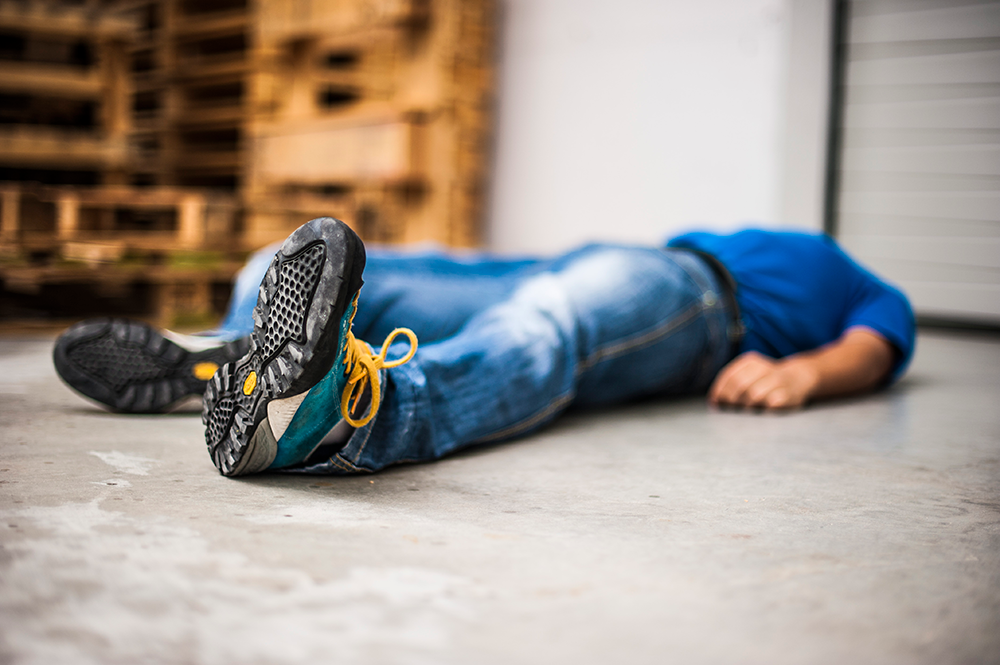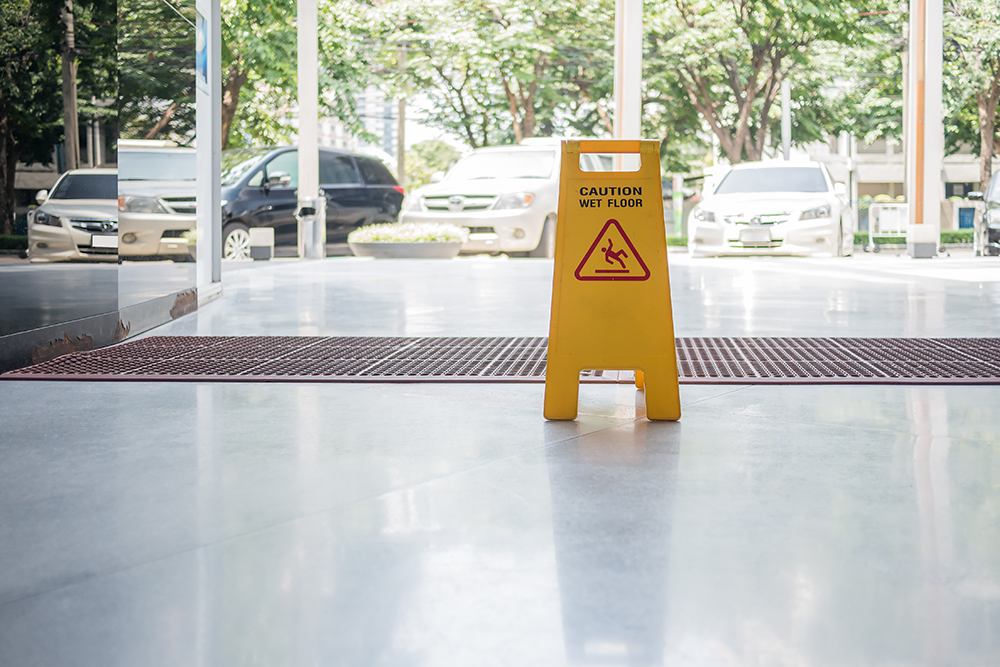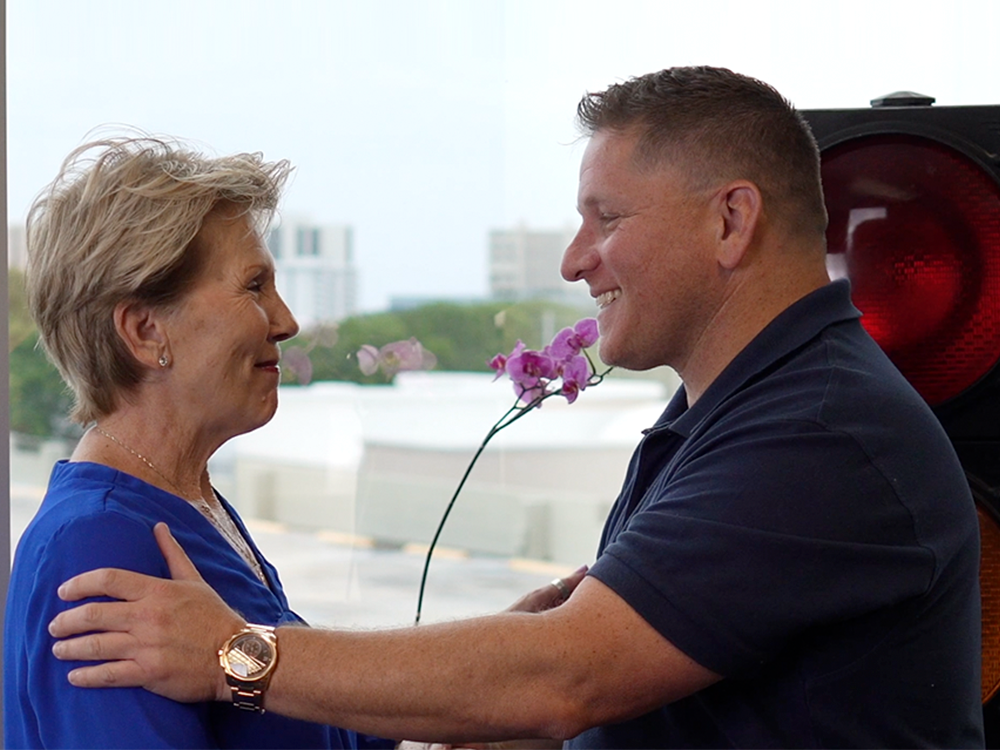What’s The Difference Between Slip and Fall and a Trip and Fall?
Unfortunately, both “slip and fall” accidents and “trip and fall” accidents are common and affect tens of thousands of people every year, sometimes leading to debilitating injury. Many people, however, including some lawyers, wrongly use these terms interchangeably. While they may appear semantically similar, their legal definitions are different.
Slip And Fall Vs. Trip And Fall
If somebody asked you about the difference between slip and fall accidents and trip and fall accidents, would you be able to tell them? The answer is, “probably not.” The distinction, however, is essential, as it can have an impact on the nature of your claim. A quality slip and fall lawyer should be able to provide you with all the information you need about the differences between the two and how it affects your case.
What Is A Slip And Fall Accident?
A slip and fall accident occurs when a person falls over as a consequence of walking on a slippery surface.
Examples of slippery surfaces include:
- Hard floors that have recently been waxed or cleaned
- Hard surfaces covered in liquid from a spill or water overflow (for instance, in a bathroom)
- Cold, hard surfaces with condensation
- Carpets with low coefficients of friction
Most people who step onto an ice rink understands that the amount of friction between their feet and the ice beneath is likely to be low because ice is slippery. Slip and fall accidents occur, however, when people believe that they have more grip underfoot than they actually do. Thus, slip and fall accidents tend to happen when a person overestimates the amount of grip that they have.
Slip and fall accidents usually result in the affected person falling backward. Instead of gripping the ground, the leading foot slides forward uncontrollably, causing the victim’s center of mass to shift behind them, causing them to topple rearward.
Since most slip and fall accidents involve falling backward in some way, they result in a distinct set of injuries, some of which can be debilitating and long-term.
The following are some of the most common types of injuries victims experience after a slip and fall accident:
- Sprained ankles. As your foot slides along the floor, it falls out of alignment with your leg, putting a strain on the ankle joint. The extreme forces this pressure generates can damage ligaments, tendons, muscles, and bones in the ankle, leading to an injury that prevents you from walking unassisted for many weeks or months.
- Sprained wrists. As people fall back after a slip, they naturally extend their hands behind them to break their fall. The wrist, therefore, has to bear the brunt of the majority of the impact. A sprained wrist is a severe injury because it often prevents the affected individual from working or leading a fulfilling life.
- Shoulder dislocation. Slip and fall accidents also frequently lead to shoulder dislocation. When people reach out to break their fall, they often rotate the shoulder into a position that puts it at a mechanical disadvantage. The impact then transmits force through the arm to the joint, which can cause muscle strain and dislocation. Many people with this kind of injury require immediate surgery.
- Brain injury. Often, people who slip and fall, hit their heads on the ground, leading to brain injury. Traumatic head injuries are incredibly dangerous and can, on occasion, be life-threatening. What’s more, because traumatic brain injuries can alter cognitive function, the victim is often unaware that their capacities have changed.
- Spine and nerve damage. The spine and surrounding nerves are delicate. Slip and fall injuries can compress the spine and damage the surrounding nerve, sometimes leading to permanent loss of motor function to some parts of the body.
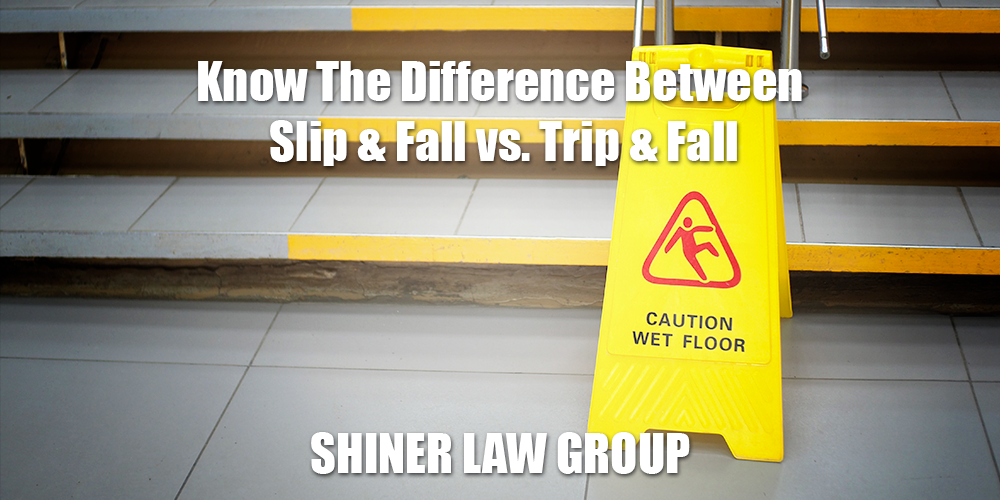
What Is A Trip And Fall Accident?
A trip and fall accident occurs when a person trips over an object on the floor and cannot bring their other leg forward fast enough to prevent the fall.
Examples of trip and fall scenarios include:
- Tripping over the elevation between the street and the sidewalk
- Uneven paving stones on the sidewalk
- Door jambs that connect the door to the floor
- Items left on the floor, such as brooms, ropes, construction materials, and boxes
Trip and fall accidents usually happen when a person doesn’t adjust their gait to accommodate an object lying on the floor, generally because they do not see it or misjudge the steps they must take to avoid it. Trip and fall accidents commonly result in the victim falling forward, instead of backward, as is the case in slip and fall accidents.
As a person walks forward, they rely on being able to put on foot in front of the other. If an object on the ground prevents their feet from moving forward, they cannot accommodate the forward motion of their upper body. Their torso continues to move forward even while their feet are stuck, causing them to topple over.
Just like slip and fall, trip and fall accidents tend to produce a distinct set of injuries. These include:
- Limb fractures. When a person falls forward, they instinctively put their arms out to break their fall. Many people involved in trip and fall accidents, therefore, experience limb fractures, especially if they are elderly.
- Neck injuries. It is common for a victim to tell a trip and fall attorney that they have a neck injury, following a trip and fall accident. As a person falls, they use their arms break the impact on the body. The head, however, continues to move towards the ground, and the neck must take the brunt of the force.
- Foot injuries. Trip and fall accidents often lead to foot and ankle injuries, especially if the foot gets caught as the person falls over. All of a sudden, their entire weight pivots around the ankle joint in a biomechanically dangerous way.
- Cuts and abrasions. Slip and fall accidents can lead to cuts and abrasions, but damage to the skin is usually worse with trip and fall events. In slip and fall injuries, the majority of the force of impact gets transmitted through the hip and side of the body. Any damage is usually internal. With trip and fall, however, the risk of grazing skin and wounds is much higher, especially on the knees, elbows, and palms of the hands. The good news is that cuts and abrasion injuries are often relatively simple to treat. After sterilizing the wound, medical professionals may offer stitches or leave the damage to heal naturally.
- Broken finger bones. In trip and fall accidents, the hands tend to take the brunt of the force of impact. It is common, therefore, for victims to experience broken finger bones after a fall. Medical professionals usually repair fractures of small hand bones by placing the injured finger in a cast and using the surrounding fingers as a brace. Broken fingers can make it impossible for a broad swathe of people to work, especially manual laborers and typists.
- Thumb sprains. Thumb injuries are common after a trip and fall accident. As the person hits the ground, the force of the impact pushes the thumb backward behind the hand, damaging the delicate tendons and ligaments that hold it in place.
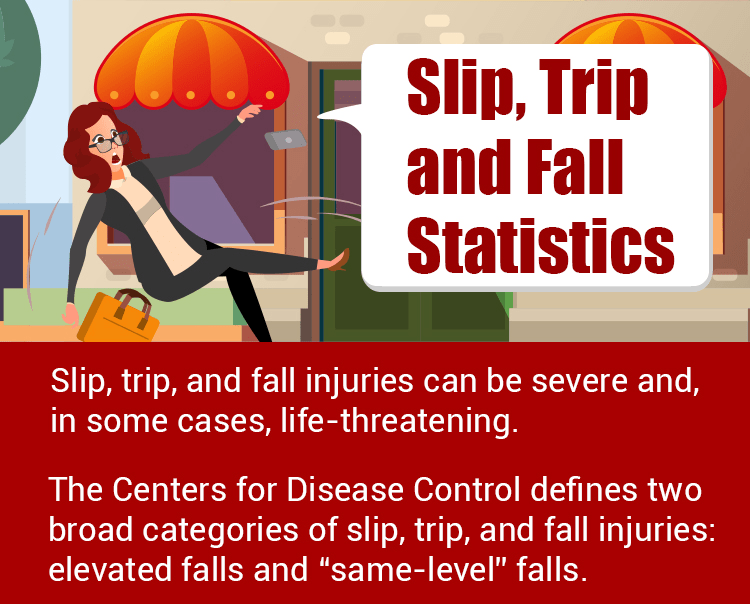
Slip, Trip And Fall Statistics
Slip, trip, and fall injuries can be severe and, in some cases, life-threatening.
The Centers for Disease Control defines two broad categories of slip, trip, and fall injuries: elevated falls and “same-level” falls.
Same-level falls occur when the individual falls onto a surface that is on a level plane with the point at which the fall began. Elevated falls, on the other hand, are where a person falls further onto ground that is lower down. For instance, a person walking along a beachfront promenade who slips on a banana skin onto the concrete is said to have experienced a “same-level” fall. By contrast, a person who trips over a bucket and falls off the promenade onto the beach below is said to have experienced an “elevated fall.” As you might imagine, elevated falls typically result in more severe injuries to the victim.
Here are some facts related to slip, trip, and fall injuries:
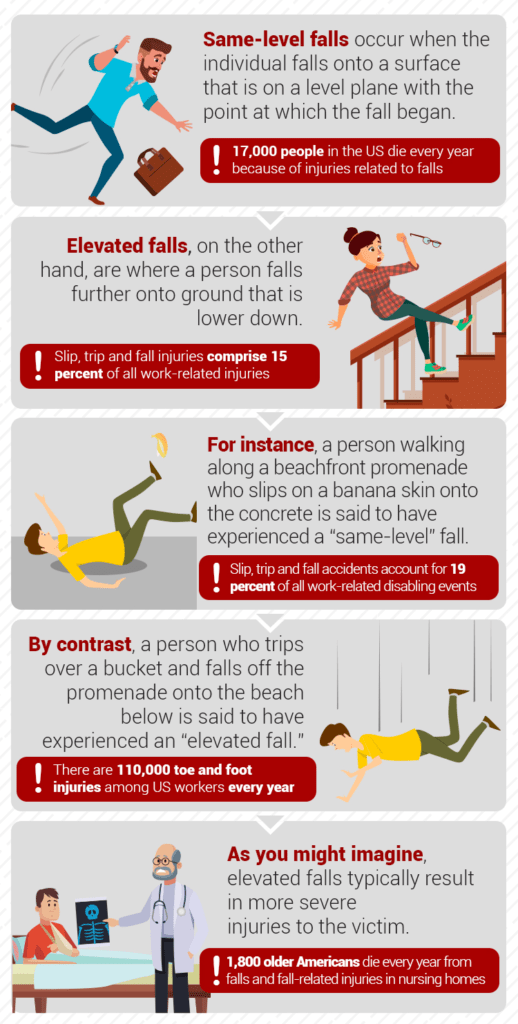
- 17,000 people in the US die every year because of injuries related to falls
- Slip, trip and fall injuries comprise 15 percent of all work-related injuries
- Slip, trip and fall injuries generate between 12 and 15 percent of all workers compensation claims
- 40 percent of elevated falls are from heights of greater than 10 feet
- Between 20 and 30 percent of people who fall will experience a moderately severe injury, such as a head injury, torn ankle ligaments, or hip fracture
- 1,800 older Americans die every year from falls and fall-related injuries in nursing homes
- Slip, trip and fall accidents are responsible for more than 45 percent of traumatic brain injury
- There are 110,000 toe and foot injuries among US workers every year
- Slip, trip and fall accidents account for 19 percent of all work-related disabling events
- Nursing home residents account for more than 20 percent of all deaths from slip, trip, and fall accidents
- More than 2 million people are treated for injuries resulting from slip, trip and fall accidents in emergency rooms every year
- The most common fractures from slip, trip, and fall accidents are of the hand, upper arm, pelvis, leg, ankle, forearm, hip and spine
What To Do After A Slip And Fall/Trip And Fall
If you’ve been involved in a slip and fall or a trip and fall accident, what should you do next?
Step 1: Seek Medical Treatment
The first step is to seek medical treatment. As we discussed in the statistics above, a fall can be a life-threatening event.
Seeking medical treatment allows you to get the treatment you need and create an official doctors’ records of events that you may be able to use later to support any legal action you take.
Step 2: Report The Incident
Slip and fall/trip and fall incidents can happen anywhere. Common locations include in the workplace, on commercial premises, at somebody’s house, or in a public space, like a sidewalk or park. Always record the location of the incident and report it to the landlord, manager, or supervisor. Request that they create a written report of the event, detailing what happened.
Step 3: Collect Witness Information
Did anyone see your slip, trip, and fall accident? If so, you may need to rely on their witness testimony at a later date if you decide to make a claim. Collect essential contact information, such as phone numbers, email addresses, and names, as this information may help you in the future.
It can also help if you take a contemporaneous picture of where the slip, trip, or fall took place so that you can document the situation. A slip and fall attorney can provide more guidance on this if you are unsure.
Step 4: Do Not Make Any Statements
This one might seem a little strange, but it is a good idea to decline to make any statements to the landlord or manager until you have spoken to a trip and fall lawyer. Don’t talk about what happened to you on social media and don’t given any statements to insurance companies until you’ve spoken to an attorney. If you say the wrong thing, you could jeopardize your chances of making a successful claim.
Step 5: Contact Your Attorney
If you are considering legal action, the best person to have on your side is an experienced slip and fall attorney who understands the legal landscape concerning slip and fall/trip and fall accidents.
Many slip, trip, and fall accidents can be complex cases requiring specialist legal expertise. At Shiner Law Group, we have a vast array of talented legal professionals ready to take on your case. With us, you don’t have to handle your situation by yourself. You can get the compensation that you deserve for the injuries that you have sustained. Make sure that you contact us today to explore your rights and options.
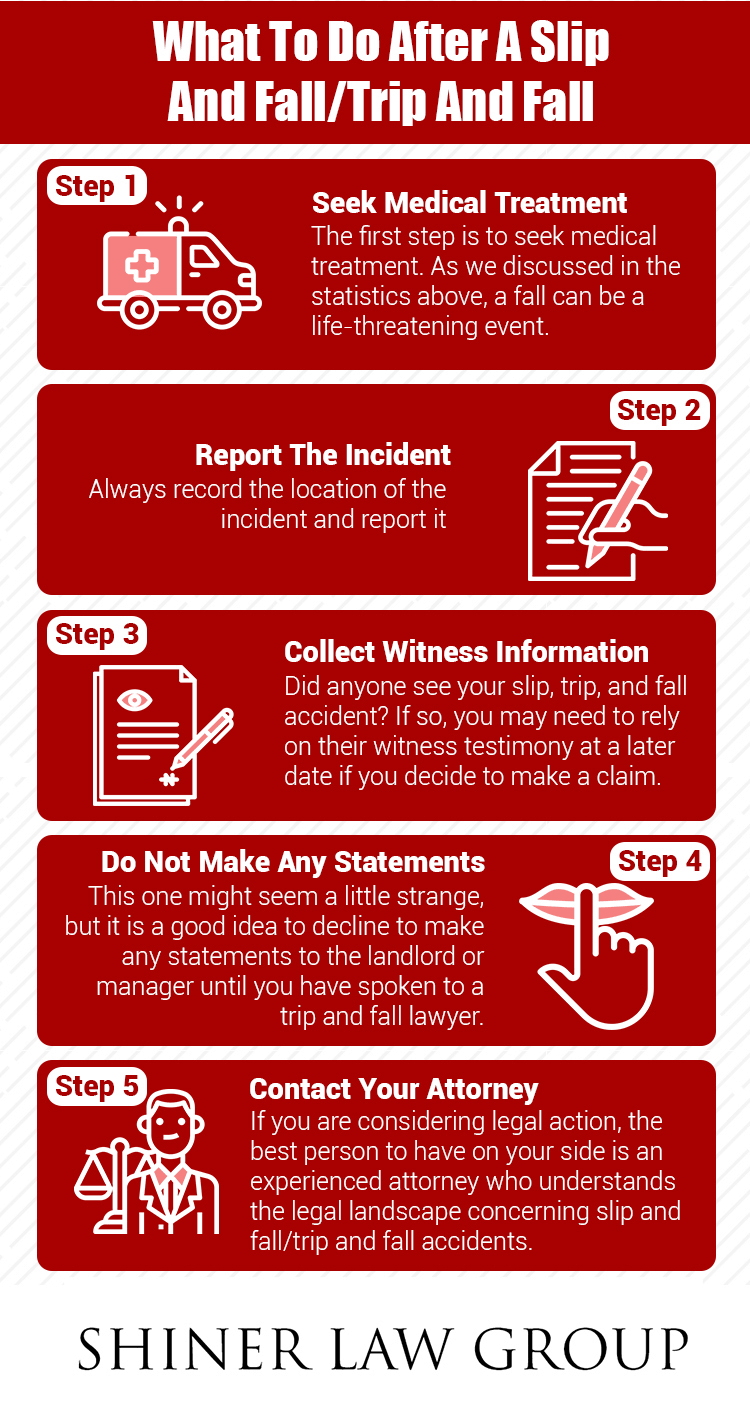
Hiring A Slip and Fall Lawyer Near Me
If you or a loved one has been injured in a slip and fall or trip and fall accident choosing the right slip and fall lawyer the first time will help relieve you from a potentially stressful situation. Handling the aftermath of a fall accident can be costly and time-consuming, that is where we can help. Our attorneys and professionals at Shiner Law Group treat every client like family, not like a number. So if you are looking for a slip and fall lawyer near me contact our firm today and speak with a lawyer for free today.
